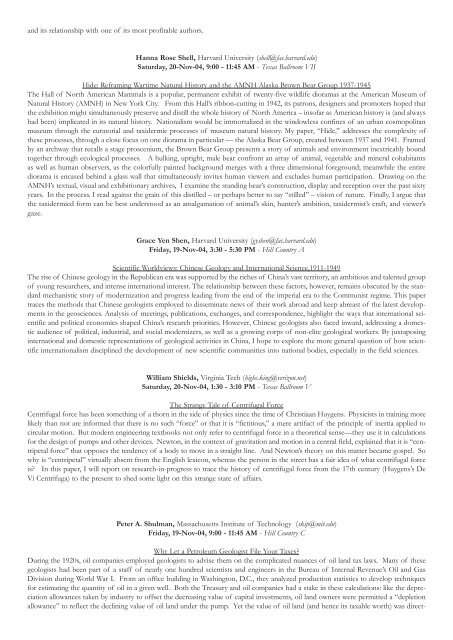Abstracts of the History of Science Society 2004 Austin Meeting 18 ...
Abstracts of the History of Science Society 2004 Austin Meeting 18 ...
Abstracts of the History of Science Society 2004 Austin Meeting 18 ...
Create successful ePaper yourself
Turn your PDF publications into a flip-book with our unique Google optimized e-Paper software.
and its relationship with one <strong>of</strong> its most pr<strong>of</strong>itable authors.<br />
Hanna Rose Shell, Harvard University (shell@fas.harvard.edu)<br />
Saturday, 20-Nov-04, 9:00 - 11:45 AM - Texas Ballroom VII<br />
Hide: Reframing Wartime Natural <strong>History</strong> and <strong>the</strong> AMNH Alaska Brown Bear Group 1937-1945<br />
The Hall <strong>of</strong> North American Mammals is a popular, permanent exhibit <strong>of</strong> twenty-five wildlife dioramas at <strong>the</strong> American Museum <strong>of</strong><br />
Natural <strong>History</strong> (AMNH) in New York City. From this Hall’s ribbon-cutting in 1942, its patrons, designers and promoters hoped that<br />
<strong>the</strong> exhibition might simultaneously preserve and distill <strong>the</strong> whole history <strong>of</strong> North America – ins<strong>of</strong>ar as American history is (and always<br />
had been) implicated in its natural history. Nationalism would be immortalized in <strong>the</strong> windowless confines <strong>of</strong> an urban cosmopolitan<br />
museum through <strong>the</strong> curatorial and taxidermic processes <strong>of</strong> museum natural history. My paper, “Hide,” addresses <strong>the</strong> complexity <strong>of</strong><br />
<strong>the</strong>se processes, through a close focus on one diorama in particular — <strong>the</strong> Alaska Bear Group, created between 1937 and 1941. Framed<br />
by an archway that recalls a stage proscenium, <strong>the</strong> Brown Bear Group presents a story <strong>of</strong> animals and environment inextricably bound<br />
toge<strong>the</strong>r through ecological processes. A hulking, upright, male bear confront an array <strong>of</strong> animal, vegetable and mineral cohabitants<br />
as well as human observers, as <strong>the</strong> colorfully painted background merges with a three dimensional foreground; meanwhile <strong>the</strong> entire<br />
diorama is encased behind a glass wall that simultaneously invites human viewers and excludes human participation. Drawing on <strong>the</strong><br />
AMNH’s textual, visual and exhibitionary archives, I examine <strong>the</strong> standing bear’s construction, display and reception over <strong>the</strong> past sixty<br />
years. In <strong>the</strong> process. I read against <strong>the</strong> grain <strong>of</strong> this distilled – or perhaps better to say “stilled” – vision <strong>of</strong> nature. Finally, I argue that<br />
<strong>the</strong> taxidermied form can be best understood as an amalgamation <strong>of</strong> animal’s skin, hunter’s ambition, taxidermist’s craft, and viewer’s<br />
gaze.<br />
Grace Yen Shen, Harvard University (gyshen@fas.harvard.edu)<br />
Friday, 19-Nov-04, 3:30 - 5:30 PM - Hill Country A<br />
Scientific Worldviews: Chinese Geology and International <strong>Science</strong>,1911-1949<br />
The rise <strong>of</strong> Chinese geology in <strong>the</strong> Republican era was supported by <strong>the</strong> riches <strong>of</strong> China’s vast territory, an ambitious and talented group<br />
<strong>of</strong> young researchers, and intense international interest. The relationship between <strong>the</strong>se factors, however, remains obscured by <strong>the</strong> standard<br />
mechanistic story <strong>of</strong> modernization and progress leading from <strong>the</strong> end <strong>of</strong> <strong>the</strong> imperial era to <strong>the</strong> Communist regime. This paper<br />
traces <strong>the</strong> methods that Chinese geologists employed to disseminate news <strong>of</strong> <strong>the</strong>ir work abroad and keep abreast <strong>of</strong> <strong>the</strong> latest developments<br />
in <strong>the</strong> geosciences. Analysis <strong>of</strong> meetings, publications, exchanges, and correspondence, highlight <strong>the</strong> ways that international scientific<br />
and political economies shaped China’s research priorities. However, Chinese geologists also faced inward, addressing a domestic<br />
audience <strong>of</strong> political, industrial, and social modernizers, as well as a growing corps <strong>of</strong> non-elite geological workers. By juxtaposing<br />
international and domestic representations <strong>of</strong> geological activities in China, I hope to explore <strong>the</strong> more general question <strong>of</strong> how scientific<br />
internationalism disciplined <strong>the</strong> development <strong>of</strong> new scientific communities into national bodies, especially in <strong>the</strong> field sciences.<br />
William Shields, Virginia Tech (highc.king@verizon.net)<br />
Saturday, 20-Nov-04, 1:30 - 3:10 PM - Texas Ballroom V<br />
The Strange Tale <strong>of</strong> Centrifugal Force<br />
Centrifugal force has been something <strong>of</strong> a thorn in <strong>the</strong> side <strong>of</strong> physics since <strong>the</strong> time <strong>of</strong> Christiaan Huygens. Physicists in training more<br />
likely than not are informed that <strong>the</strong>re is no such “force” or that it is “fictitious,” a mere artifact <strong>of</strong> <strong>the</strong> principle <strong>of</strong> inertia applied to<br />
circular motion. But modern engineering textbooks not only refer to centrifugal force in a <strong>the</strong>oretical sense—<strong>the</strong>y use it in calculations<br />
for <strong>the</strong> design <strong>of</strong> pumps and o<strong>the</strong>r devices. Newton, in <strong>the</strong> context <strong>of</strong> gravitation and motion in a central field, explained that it is “centripetal<br />
force” that opposes <strong>the</strong> tendency <strong>of</strong> a body to move in a straight line. And Newton’s <strong>the</strong>ory on this matter became gospel. So<br />
why is “centripetal” virtually absent from <strong>the</strong> English lexicon, whereas <strong>the</strong> person in <strong>the</strong> street has a fair idea <strong>of</strong> what centrifugal force<br />
is? In this paper, I will report on research-in-progress to trace <strong>the</strong> history <strong>of</strong> centrifugal force from <strong>the</strong> 17th century (Huygens’s De<br />
Vi Centrifuga) to <strong>the</strong> present to shed some light on this strange state <strong>of</strong> affairs.<br />
Peter A. Shulman, Massachusetts Institute <strong>of</strong> Technology (skip@mit.edu)<br />
Friday, 19-Nov-04, 9:00 - 11:45 AM - Hill Country C<br />
Why Let a Petroleum Geologist File Your Taxes?<br />
During <strong>the</strong> 1920s, oil companies employed geologists to advise <strong>the</strong>m on <strong>the</strong> complicated nuances <strong>of</strong> oil land tax laws. Many <strong>of</strong> <strong>the</strong>se<br />
geologists had been part <strong>of</strong> a staff <strong>of</strong> nearly one hundred scientists and engineers in <strong>the</strong> Bureau <strong>of</strong> Internal Revenue’s Oil and Gas<br />
Division during World War I. From an <strong>of</strong>fice building in Washington, D.C., <strong>the</strong>y analyzed production statistics to develop techniques<br />
for estimating <strong>the</strong> quantity <strong>of</strong> oil in a given well. Both <strong>the</strong> Treasury and oil companies had a stake in <strong>the</strong>se calculations: like <strong>the</strong> depreciation<br />
allowances taken by industry to <strong>of</strong>fset <strong>the</strong> decreasing value <strong>of</strong> capital investments, oil land owners were permitted a “depletion<br />
allowance” to reflect <strong>the</strong> declining value <strong>of</strong> oil land under <strong>the</strong> pump. Yet <strong>the</strong> value <strong>of</strong> oil land (and hence its taxable worth) was direct-
















